Posts Tagged: lavender
Seeing Red: Holiday Red
Yes, Virginia, there is such a thing as "red pollen." Like people, pollen comes in many colors and all are beautiful. All. The floral source...
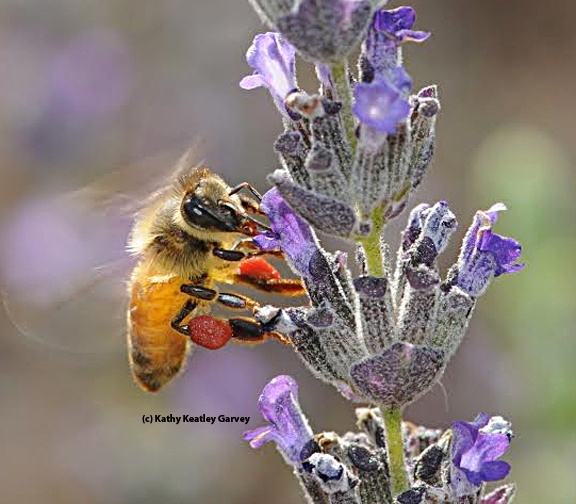
Honey bee with red pollen (from neighboring rock purslane) sipping nectar from lavender. (Photo by Kathy Keatley Garvey)
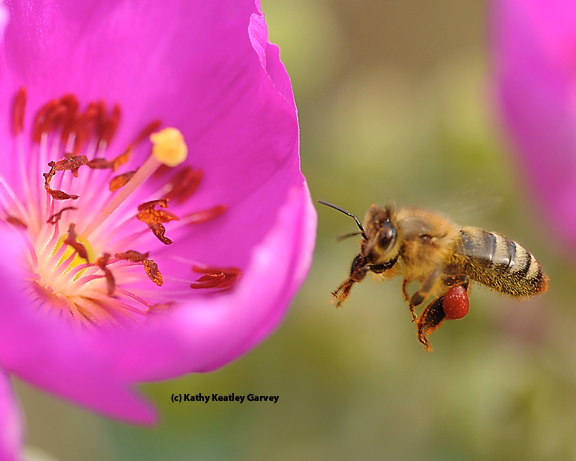
Honey bee, packing red pollen, returning to a rock purslane blossom. (Photo by Kathy Keatley Garvey)
Dancing the Flamenco
One of TV's popular programs is "Dancing with Stars." The reality show pairs celebrities with professional ballroom dancers in a competition to win...
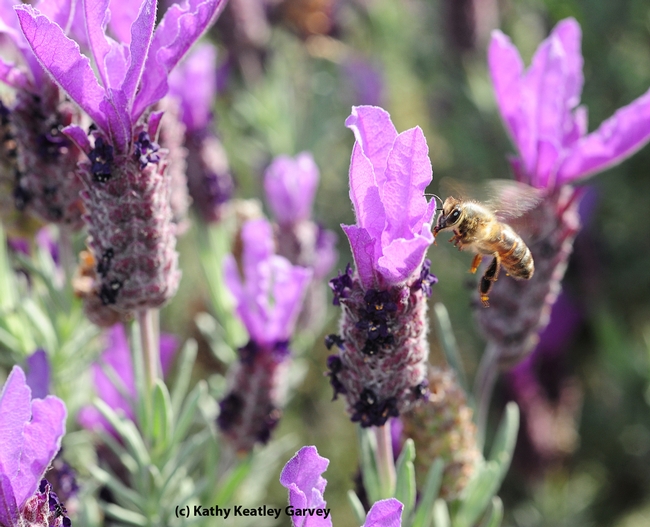
Honey bee greets a Spanish lavender blossom. (Photo by Kathy Keatley Garvey)
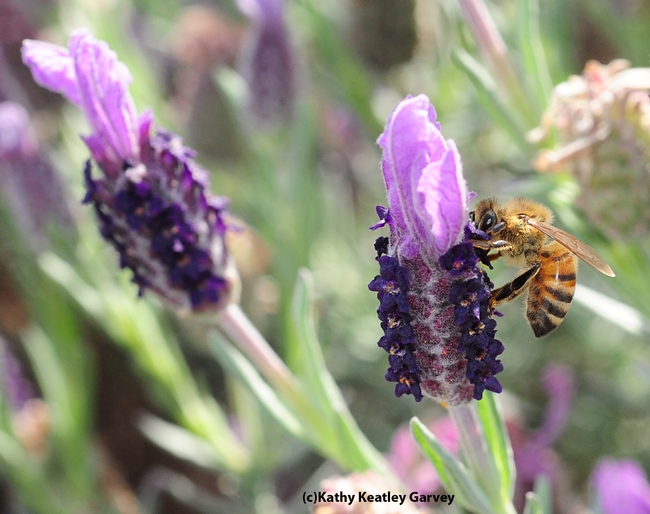
Honey bee nectaring Spanish lavender. (Photo by Kathy Keatley Garvey)
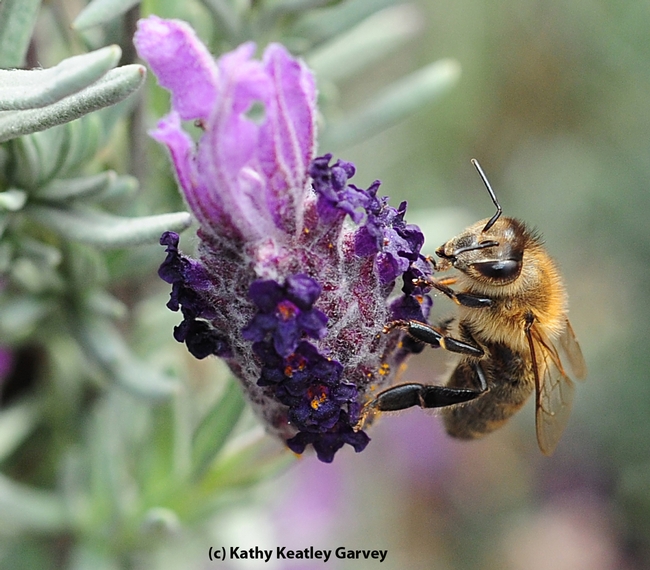
Close-up of honey bee partnering with a blossom. (Photo by Kathy Keatley Garvey)
Limonium
One of my favorite plants is Limonium, aka statice or sea lavender. It has solved a problem area in my front yard.
Previously, The edge of the front lawn sloped down with a drop of about 12 or so inches from the cement steps up to the front of the house. The edge of the grass showed the roots of the turf and was frequently "burned" by the edge trimmer or lawn mower. This space was like a "no man's land" with the bare edge of concrete offering anything but curb appeal.
This part of the garden receives full exposure to the wind and sun. I choose to try some statice as a border alongside this walkway. I have seen this hardy plant survive and even thrive in similar conditions, no doubt the common name "sea lavender" was earned by the many gardens it has inhabited in the many gardens with a marine influence.
The statice has been in place now about five years. Snails are attracted by the leaves but the plants are so vigorous the damage is minimal. I trim the flower stalks occasionally when they fade. Soon there after new shoots will appear to take their place. My garden reference books say the "perezii" variety will bloom over the long summer but my experience is an almost continuous bloom through out the year. The flower clusters can grow up to 3 feet across and consist of a rich purple calyx with a tiny white corolla. The blooms dry very easily by hanging upside down until dry but I find they can be pretty messy. Since these plants bloom continuously, I just cut the fresh stalks when needed. Very little water is needed for these established plants and I do not add any fertilizer at all.
Enjoy this very giving plant in your garden with very little effort on your part.

Sea lavender. (photo by Trisha Rose)
The Lavender Blossom Special
If you want to take photos of honey bees in flight, do so early in the morning. They don't move as fast and the lighting is to die for.This morning...
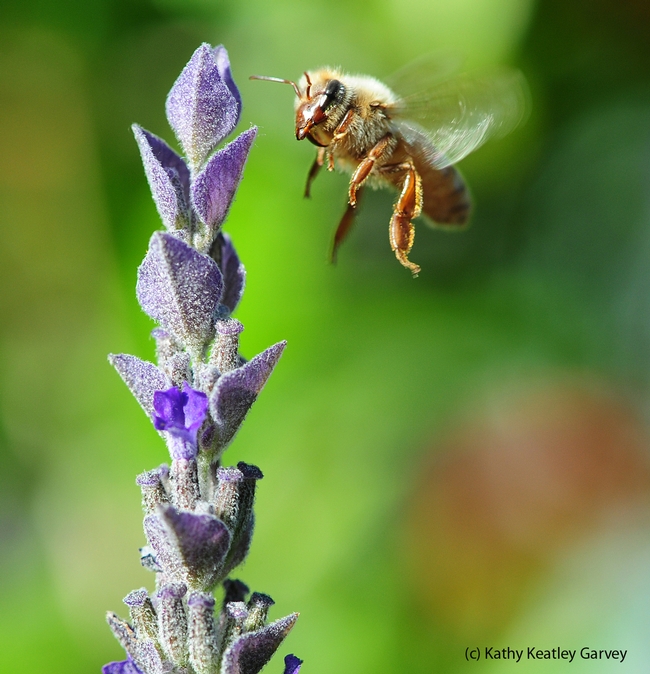
Honey bee in flight, heading toward a lavender blossom. Note the varroa mite on her head.(Photo by Kathy Keatley Garvey)
Big Blue Lavender
Several years ago, my husband and I cleaned out the 3' x 40' strip of soil between our house and our neighbors. There were several roses that were salvaged, but everything else was removed. This buffer zone between houses needed soil amendments, irrigation changes and plants that could handle hot afternoon sun. My husband wanted color and I wanted scent, so we compromised. He purchased two crape myrtles in red and plum and I went shopping for lavenders. Knowing that lavender is a Mediterranean plant, has few problems (root rot, mildew and rust), required little water and LOVED the hot afternoon sun, made it an ideal choice. The flowers would be harvested to use for decorating and smell, a real bonus. Many of the plants located at the nursery would grow too large for this narrow strip. Searching through the plant inventory at a local herb farm, Gros Bleu Lavender (Lavandula x intermedia) was found and it only grew to 13 inches. The plant marker also noted that it had extremely long flower heads and navy blue flowers. Eureka! My search was over and I have not been disappointed with my choice. They finished blooming last month and have been trimmed back to compact round orbs to keep them tidy and healthy, ready to fill out and scent our garden again next year!

